Vases and Bowls
This particular vase, with its speckled glaze and rounded form, is characteristic of contemporary studio pottery. Such pieces are often created by individual artists or small studios, with variations in glaze application and firing contributing to the unique character of each item. The earthy tones and textured surface suggest a rustic or naturalistic aesthetic, popular in modern decorative arts.
Studio pottery emerged in the late 19th and early 20th centuries as artists sought to elevate ceramics beyond purely functional or industrial production. These potters often focused on unique glazes, forms, and decorative techniques, emphasizing the artist's hand in the creation process. This movement led to a greater appreciation for pottery as an art form, with many pieces being collected for their aesthetic qualities.
To inquire about pricing and availability, please email BALL HILL The Arcade at info@ballhill.com.
Signed 'Banker' or 'Barker', dated 1986. (United States)
The late 20th century saw a flourishing of studio pottery, particularly in the United States, where individual artists and small workshops produced unique ceramic pieces. These artists often experimented with glazes, forms, and decorative techniques, drawing inspiration from both historical traditions and contemporary art movements. The year 1986 falls within this vibrant period, characterized by a focus on craftsmanship and artistic expression.
Potters from this era often signed or marked their work with their name or studio name, along with the year of creation, to authenticate their pieces. These marks are invaluable for collectors and historians, providing direct links to the artist and the specific time of production. The presence of such a mark on this vase suggests it is a deliberate artistic creation rather than a mass-produced item.
To inquire about pricing and availability, please email BALL HILL The Arcade at info@ballhill.com.
Drawing on the personal inspiration of his late grandmother, Rebecca Olivia Martin, Austin Snowden has created a series of beautiful pots. Each pot feature a lovely lavender color, a shade that was a favorite of both Austin and his grandmother. Each piece is a testament to Austin's unique firing process, where the pots are fired to a searing 1,000° Fahrenheit. They are then carefully moved to a reduction chamber and, while still hot, are quenched in water. This final step is what stops the oxidation process and gives each pot its own unique character.
To inquire about pricing and availability, please email BALL HILL The Arcade at info@ballhill.com.
Drawing on the personal inspiration of his late grandmother, Rebecca Olivia Martin, Austin Snowden has created a series of beautiful pots. Each pot feature a lovely lavender color, a shade that was a favorite of both Austin and his grandmother. Each piece is a testament to Austin's unique firing process, where the pots are fired to a searing 1,000° Fahrenheit. They are then carefully moved to a reduction chamber and, while still hot, are quenched in water. This final step is what stops the oxidation process and gives each pot its own unique character.
To inquire about pricing and availability, please email BALL HILL The Arcade at info@ballhill.com.
Heisey Glass Company, founded in Newark, Ohio, in 1896, was known for producing high-quality, elegant glassware. Their Crystolite line, introduced in the early 20th century, was particularly popular for its clarity and intricate designs. Heisey pieces are often collected for their distinctive molds and the company's commitment to craftsmanship.
This particular leaf-shaped dish is a classic example of Heisey's Crystolite pattern, showcasing the delicate ribbing and clear glass that defined the line. These dishes were commonly used as nut dishes or small serving pieces, adding a touch of sophistication to any table setting. Heisey ceased production in 1957, making their pieces increasingly sought after by collectors.
To inquire about pricing and availability, please email BALL HILL The Arcade at info@ballhill.com.
The Heisey Glass Company, founded in 1896 in Newark, Ohio, was known for producing high-quality, elegant glassware. Their pieces were often characterized by their clarity, brilliance, and intricate designs. Heisey's 'Crystolite' pattern, introduced in the 1930s, is particularly recognizable for its clear, pressed glass with a distinctive ribbed or paneled design.
This pattern was popular for a variety of serving pieces, including relish trays, bowls, and platters. The company ceased production in 1957, making their glassware increasingly collectible. Pieces like this relish tray are sought after for their vintage charm and the quality craftsmanship that Heisey was known for.
To inquire about pricing and availability, please email BALL HILL The Arcade at info@ballhill.com.
Villeroy & Boch 'Quadra' Crystal Serving Bowl (Late 20th Century, West Germany)
Villeroy & Boch, founded in 1748, is a highly respected ceramics manufacturer known for its quality and design. The company has a long history of producing fine tableware, decorative items, and crystalware. Their designs often blend classic elegance with modern aesthetics.
The 'Quadra' line, produced in West Germany, is characterized by its geometric shapes and ribbed design, which gives it a distinctive and contemporary look. These pieces were popular during the late 20th century and are still sought after by collectors today. Villeroy & Boch crystal bowls are known for their clarity and craftsmanship, making them both functional and decorative.
To inquire about pricing and availability, please email BALL HILL The Arcade at info@ballhill.com.
Celadon pottery originated in China and has been produced for centuries, prized for its subtle green glaze that resembles jade. The glaze is achieved through a specific firing process that reduces iron oxide to ferrous oxide, creating the distinctive color. Celadon ware was particularly popular during the Song Dynasty (960-1279 AD).
This vase, with its 10" x 10" dimensions, is a substantial piece, making it more desirable as a decorative item. The matte finish and the style of the floral design suggest a contemporary interpretation of classic celadon aesthetics.
While it may not be an antique, its decorative appeal and craftsmanship still give it considerable value.
To inquire about pricing and availability, please email BALL HILL The Arcade at info@ballhill.com.
The vase is characteristic of the Art Nouveau movement, which flourished from the 1890s to the 1910s.
This era was characterized by its emphasis on organic forms, intricate designs, and the incorporation of natural elements. Art Nouveau aimed to break away from traditional artistic styles, embracing modernity and innovation in design.
The vase's floral motifs, flowing lines, and use of color are all hallmarks of Art Nouveau aesthetics.
Given the style and the floral design, it resembles some of the pottery produced by companies like Amphora or even some of the more elaborate pieces from makers in Longwy, France, known for their enameled pottery.
Without a maker's mark, it's difficult to pinpoint the exact origin, but the quality suggests a well-regarded manufacturer from the period.
Pieces from this period often feature stylized depictions of flowers, leaves, and other natural forms, reflecting a desire to bring the beauty of the natural world into everyday objects. The style was particularly popular in Europe and the United States, influencing various art forms, including ceramics, glasswork, and decorative arts.
To inquire about pricing and availability, please email BALL HILL The Arcade at info@ballhill.com.
This is a large, mid-late 20th-century decorative brass bowl with a hammered finish and applied brass studs, resting on a separate brass-wrapped base.
Handmade in India. 17.5” round.
Large decorative brass bowls, especially those with intricate hammering and applied ornamentation, were popular during the 19th and early 20th centuries. These bowls often served as centerpieces or decorative accents in homes, reflecting a taste for exotic and handcrafted items.
The practice of wrapping a base in brass adds to the aesthetic appeal and structural integrity of the piece. This technique was commonly employed to elevate and showcase decorative objects, enhancing their visual impact. The size of the bowl, at 17.5 inches in diameter, suggests it was intended to be a prominent feature in a room, drawing attention to its craftsmanship and design.
To inquire about pricing and availability, please email BALL HILL The Arcade at info@ballhill.com.
Red Wing Pottery was founded in Red Wing, Minnesota, in 1877. The company produced a wide range of stoneware, art pottery, and dinnerware. Red Wing is particularly known for its mid-century modern designs and durable, functional pieces that were popular in American households.
The company ceased production in 1967, making vintage Red Wing pieces increasingly collectible. The matte pastel colors, like the pink seen in this vase, were a signature of Red Wing's art pottery line. These pieces often have a simple, elegant form that fits well with both vintage and contemporary decor.
To inquire about pricing and availability, please email BALL HILL The Arcade at info@ballhill.com.
Stevens and Williams was a renowned British glass manufacturer celebrated for its innovative techniques and artistic designs during the Victorian era. Founded in the early 19th century, the company gained prominence for its exquisite cameo glass, intricate floral decorations, and vibrant color combinations.
Their creations often featured elaborate shapes and meticulous craftsmanship, reflecting the opulence and elegance of the period.
Victorian art glass baskets, like this one, were popular decorative items, showcasing the era's fascination with ornate designs and luxurious materials. These baskets were often used as centerpieces or ornamental displays, adding a touch of sophistication to Victorian homes. The combination of delicate glasswork and vibrant colors made them highly sought after collectibles
To inquire about pricing and availability, please email BALL HILL The Arcade at info@ballhill.com.
Mercury glass, also known as silvered glass, gained popularity in the mid-19th century as an affordable alternative to solid silver. It was created by using a double-walled glass object and filling the space between the walls with a liquid silvering compound, usually containing silver nitrate. This technique gave the glass a reflective, metallic appearance similar to silver.
Mercury glass items were widely produced in Europe and the United States, becoming fashionable decorative pieces in homes. Vases, candlesticks, and ornaments were among the common items made using this method. While antique mercury glass pieces are sought after by collectors, modern reproductions are also available, often used for decorative purposes due to their vintage aesthetic.
To inquire about pricing and availability, please email BALL HILL The Arcade at info@ballhill.com.
Two Fostoria ‘Coronet’ Bonbon Dishes
The Fostoria Glass Company was founded in Fostoria, Ohio, in 1887, and later moved to Moundsville, West Virginia. The company produced high-quality glassware and tableware for over a century, becoming known for its elegant designs and meticulous craftsmanship. Fostoria's ‘Coronet’ pattern, introduced in 1937, featuring a distinctive apple shape and embossed leaf design, was one of Fostoria's popular creations.
Bonbon dishes, like these, were popular during the mid-20th century for serving candies, nuts, and other small treats. The ‘Coronet’ pattern's clear glass and graceful apple shape make these dishes particularly appealing to collectors of vintage glassware. The large bowl and small dish would have been part of a larger set of tableware in the ‘Coronet’ pattern.
Fostoria ceased production in 1986, making their vintage pieces highly sought after by collectors today.
To inquire about pricing and availability, please email BALL HILL The Arcade at info@ballhill.com.
Antique Heisey Crystolite Glass ‘Ridgeleigh’ Punch Bowl Set (bowl, underplate, and 14 cups)
Circa 1938-1957
Bowl measures 11.5” wide x 6” high
Underplate measures 18.5” round
Heisey Glass was founded in Newark, Ohio, in 1895 by A.H. Heisey. The company was known for producing high-quality, elegant glassware, often featuring intricate designs and a distinctive clarity.
Crystolite was one of Heisey's most popular glass patterns, introduced around 1938 and produced until the company closed in 1957. Heisey's 'Ridgeleigh' pattern is characterized by its heavy glass, large vertical ribs and delicate form, reflecting the Art Deco influences of the time.
Crystolite is a term used for lead-free crystal glass. It is typically made by machine and is known for its durability and dishwasher safety. Despite being lead-free, Crystolite maintains a high level of clarity and brilliance, similar to lead crystal. Crystolite is known for its strength and resistance to damage.
This pattern was popular for both formal and casual dining settings. The company ceased production in 1957, making vintage Heisey pieces increasingly sought after by collectors.
To inquire about pricing and availability, please email BALL HILL The Arcade at info@ballhill.com.
This is a Villeroy & Boch Neptune Crystal Bowl. (12.5" W x 6.5" H)
Villeroy & Boch is a renowned ceramics and glass manufacturer with a rich history dating back to 1748. Founded in the village of Audun-le-Tiche, Lorraine, by François Boch and later joined by Nicolas Villeroy, the company has become synonymous with high-quality tableware, decorative items, and architectural ceramics and glass. Their designs often blend traditional craftsmanship with innovative techniques, resulting in pieces that are both functional and aesthetically pleasing.
Villeroy & Boch's Neptune line, known for its elegant crystal serving bowls and centerpieces, showcases the company's commitment to excellence in glassmaking. The scalloped edges and flower-shaped design of these bowls reflect the artistic sensibilities of the period, making them highly sought after by collectors and enthusiasts alike. The Neptune series exemplifies Villeroy & Boch's ability to create timeless pieces that enhance any dining or display setting.
To inquire about pricing and availability, please email BALL HILL The Arcade at info@ballhill.com.
White Striped Handcrafted Studio Art Glass.
13” tall x 7.5” wide
Handcrafted Contemporary Green Drip-Glazed Ceramic Vase (12.5” tall)
The glaze effect is achieved by allowing the top layer of glaze to run down the sides during firing. Influenced by the art pottery tradition, showcasing a flowing glaze effect, the style is reminiscent of the experimental glaze techniques that were popular during the early 20th century, where potters sought to create visually striking and unique surface finishes.
To inquire about pricing and availability, please email BALL HILL The Arcade at info@ballhill.com.
Iina Vuorivirta Finnish Swirled Green and White Art Glass Vase (11” tall)
lina Vuorivirta (b. 1988) is a Finnish designer who won the Young Designer of the Year award by Design Forum Finland in 2013. Vuorivirta graduated from the Lahti Institute of Design in 2007, and she has also studied in Stockholm at Beckmans College of Design in 2010-2011 and Konstfack University of Arts, Crafts and Design in 2012-2014. Vuorivirta has worked as Ikea's in-house designer since 2015.
To inquire about pricing and availability, please email BALL HILL The Arcade at info@ballhill.com.
Blue Aqua Ceramic Cut-Out Vase
10” x 6”
To inquire about pricing and availability, please email BALL HILL The Arcade at info@ballhill.com.
‘Mugnoni’ technique vase designed by Ercole Barovier for Barovier & Toso in Murano, Italy (circa 1938).
6 1/4” high with a 5” opening
The vase has a distinctive truncated cone shape with applied prunts (glass blobs) and a fully iridescent surface.
Ercole Barovier was a renowned Italian glass artist who significantly impacted modernist glassmaking.
The ‘Mugnoni’ technique was achieved by the Murano artist by mouth-blowing air bubbles inside the crystal and creating this eye-catching glass spikes.
Murano glass is produced on the Venetian island of Murano, Italy, known for its centuries-old glassmaking tradition.
To inquire about pricing and availability, please email BALL HILL The Arcade at info@ballhill.com.
Mid-Century Orrefors Crystal bowl (14”).
Orrefors is a renowned Swedish glassworks company founded in 1918, though its roots trace back to 1726 with the establishment of the Orrefors ironworks. The company is celebrated for its innovative glass designs and high-quality craftsmanship, often collaborating with prominent artists to create unique and artistic pieces. Orrefors has played a significant role in shaping the landscape of modern glass art.
Orrefors crystal bowls are highly sought after by collectors for their clarity, elegance, and artistic merit. The heart-shaped indentations and signed base are characteristic of Orrefors designs, reflecting the company's commitment to both form and function. These bowls often serve as decorative centerpieces or functional serving dishes, adding a touch of sophistication to any setting.
To inquire about pricing and availability, please email BALL HILL The Arcade at info@ballhill.com.
Mid-century Handkerchief vases and bowls gained popularity in the mid-20th century, particularly from the 1950s through the 1970s. These pieces are characterized by their free-form, flowing shapes that mimic the appearance of a draped or folded handkerchief. The style was a departure from more traditional, symmetrical glass designs, embracing organic forms and a sense of movement.
Many glassmakers, including notable companies like Steuben and Fenton, produced handkerchief vases and bowls during this period. These pieces were often made using techniques such as free-blowing and hand-shaping, allowing artisans to create unique and expressive forms. The clear glass allows the form of the piece to be the focus. These bowls were popular as decorative items and centerpieces in homes of the era.
To inquire about pricing and availability, please email BALL HILL The Arcade at info@ballhill.com.
Steuben Glass Works was founded in 1903 in Corning, New York, by Frederick Carder and Thomas G. Hawkes. Carder, an English glass artist, brought his expertise in colored glass to America, where Steuben quickly became renowned for its innovative techniques and high-quality art glass. The company's signature clear crystal, known for its exceptional clarity and brilliance, was introduced later and became a hallmark of Steuben's elegant designs.
Steuben pieces are highly sought after by collectors for their timeless beauty and craftsmanship. The company ceased production in 2011, adding to the desirability of vintage Steuben glass. This particular bowl, with its distinctive looped design, exemplifies the artistic flair and technical skill that made Steuben a leader in American glassmaking.
To inquire about pricing and availability, please email BALL HILL The Arcade at info@ballhill.com.
Tall Carrara Marble Vase
18” H x 7” D
Marble vases have been used for decorative and functional purposes since ancient times, with examples found in various cultures, including ancient Greece and Rome. Carrara marble, sourced from Carrara, Italy, is particularly prized for its purity and fine grain, making it a popular choice for sculptures and architectural elements. The use of marble in vase design reflects a desire for elegance and durability, as well as an appreciation for the natural beauty of the stone.
In modern times, marble vases continue to be produced, often drawing inspiration from classical forms while incorporating contemporary design elements. These vases can range from simple, minimalist designs to more elaborate, sculptural pieces.
Blue and white porcelain originated in China during the Yuan Dynasty (1279-1368) and became a dominant style during the Ming (1368-1644) and Qing (1644-1912) dynasties. The cobalt blue pigment used for the decoration was often imported from Persia, adding to the value and prestige of these wares. The designs typically feature landscapes, figures, and auspicious symbols.
These vases were produced for both domestic use and export, becoming highly sought after in Europe and other parts of the world. The technique involves painting the design onto the porcelain body before glazing and firing at high temperatures. The resulting pieces are prized for their beauty, durability, and cultural significance.
To inquire about pricing and availability, please email BALL HILL The Arcade at info@ballhill.com.
A Blenko hand-blown vase with a clear glass body and an embedded spiraled turquoise glass rod.
15 1/4" high
Blecko is known for their exquisite color and skilled craftsmanship. The vase features a clear glass body with a spiraled turquoise glass rod embedded within, a signature Blenko design element. The tall, tapered shape with a gently rolled lip and substantial base are characteristic of Blenko vases. Authentic Blenko glass has a pontil mark where it was broken off the pontil rod during production.
The Blenko Glass Company has been a family owned and operated company since 1893. They have been located in Milton, WV since 1921. Exquisite color, skilled craftsmen, and imaginative designs have made Blenko famous in the time-honored craft of hand-blown glass.
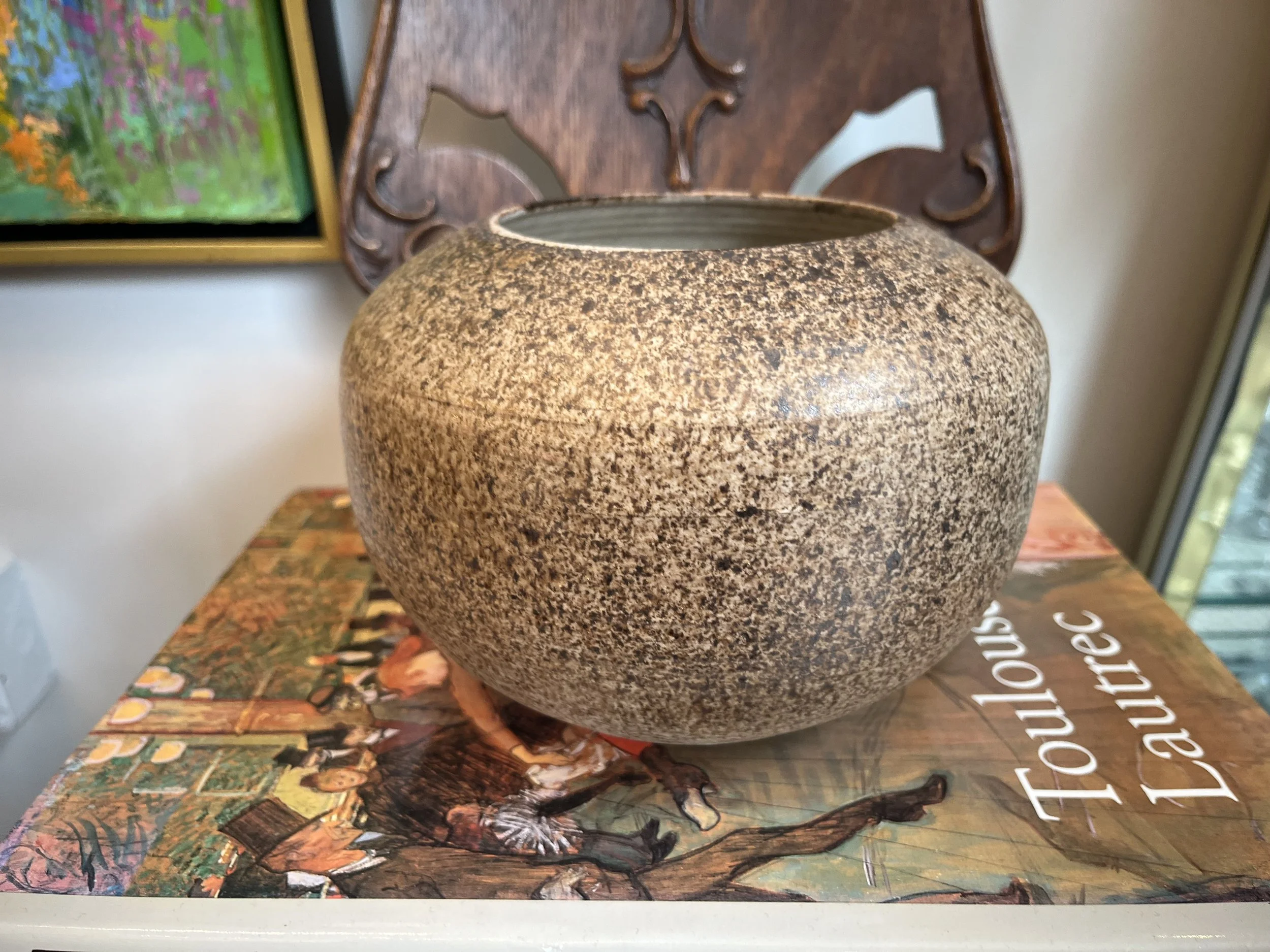
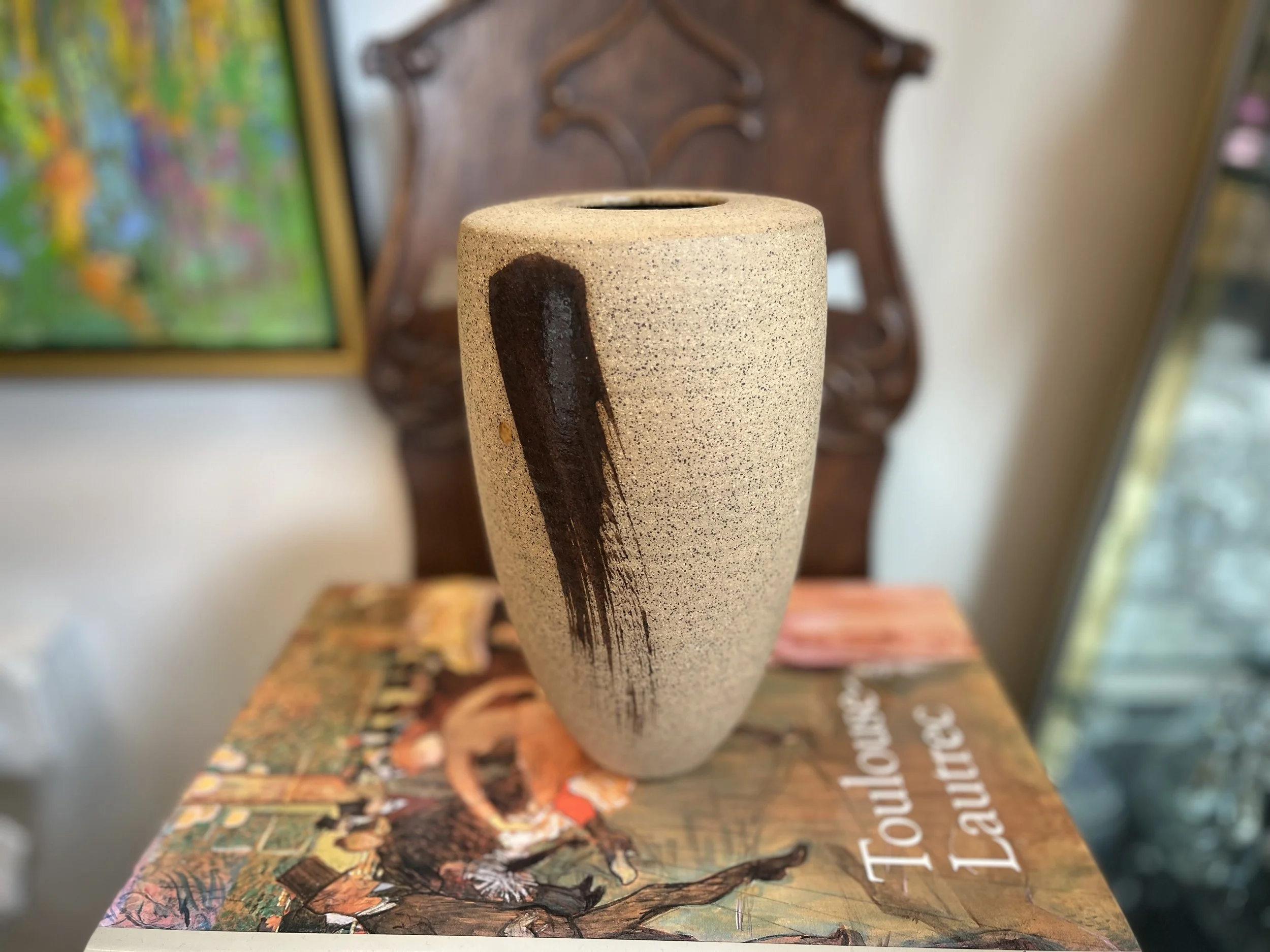
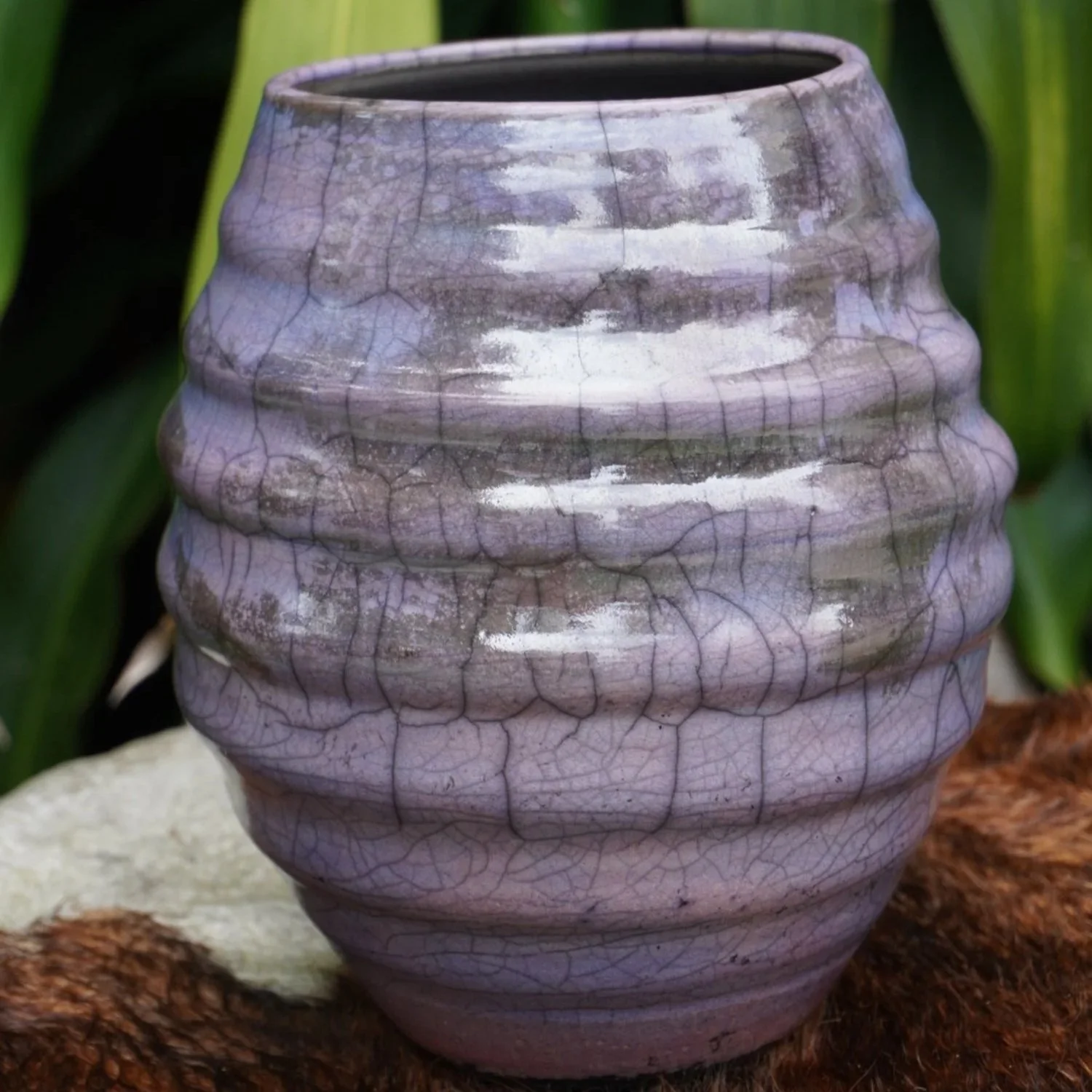
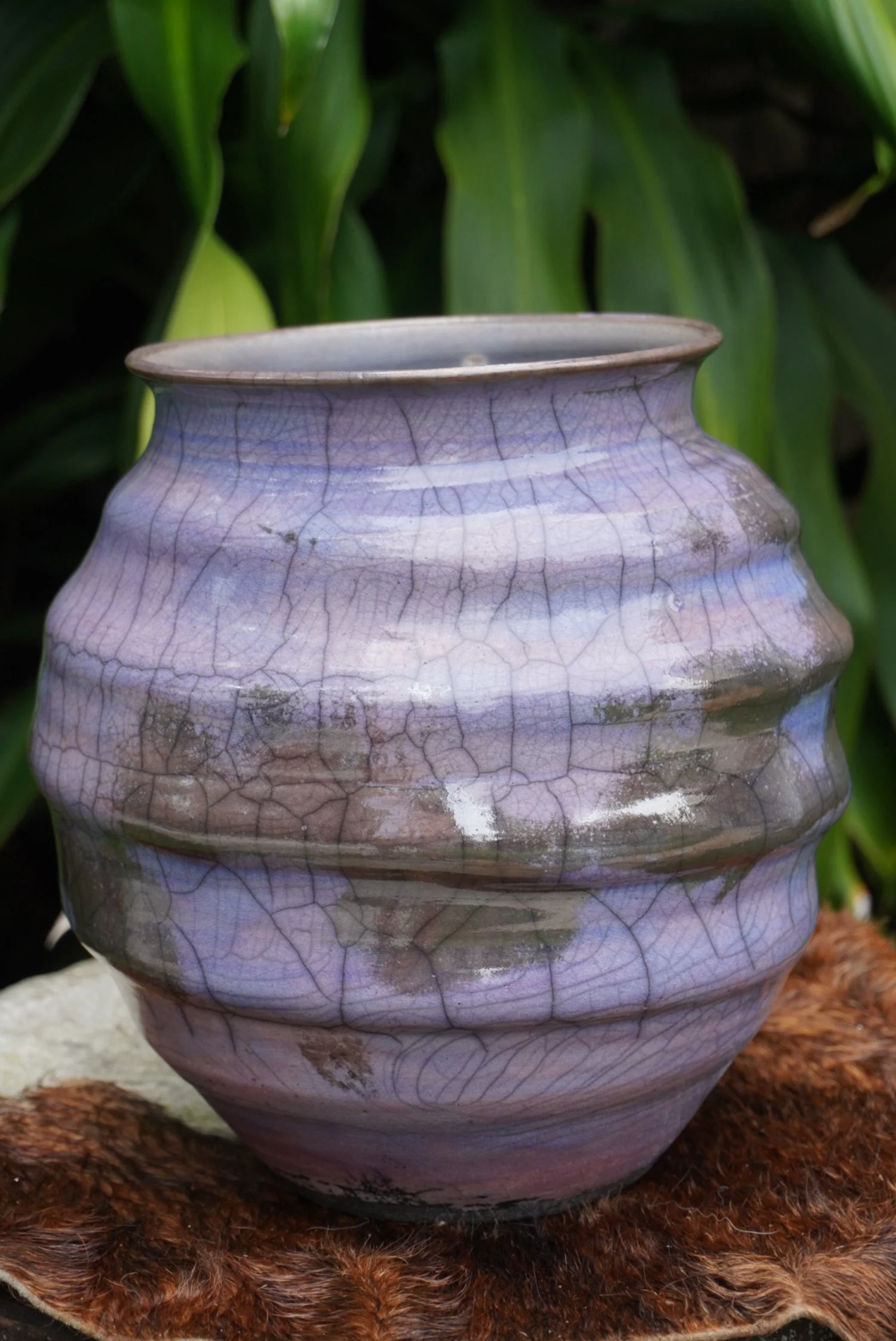
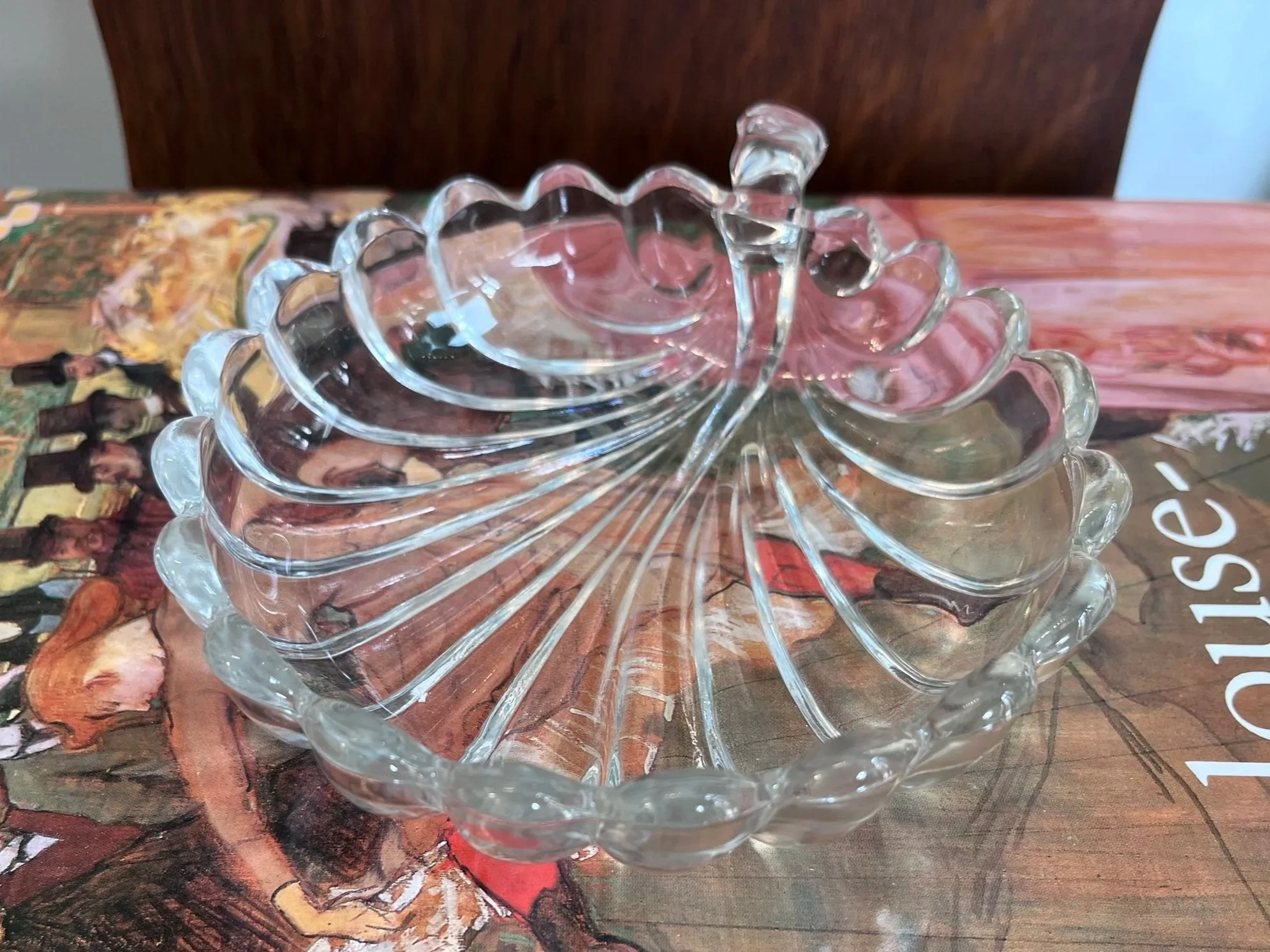

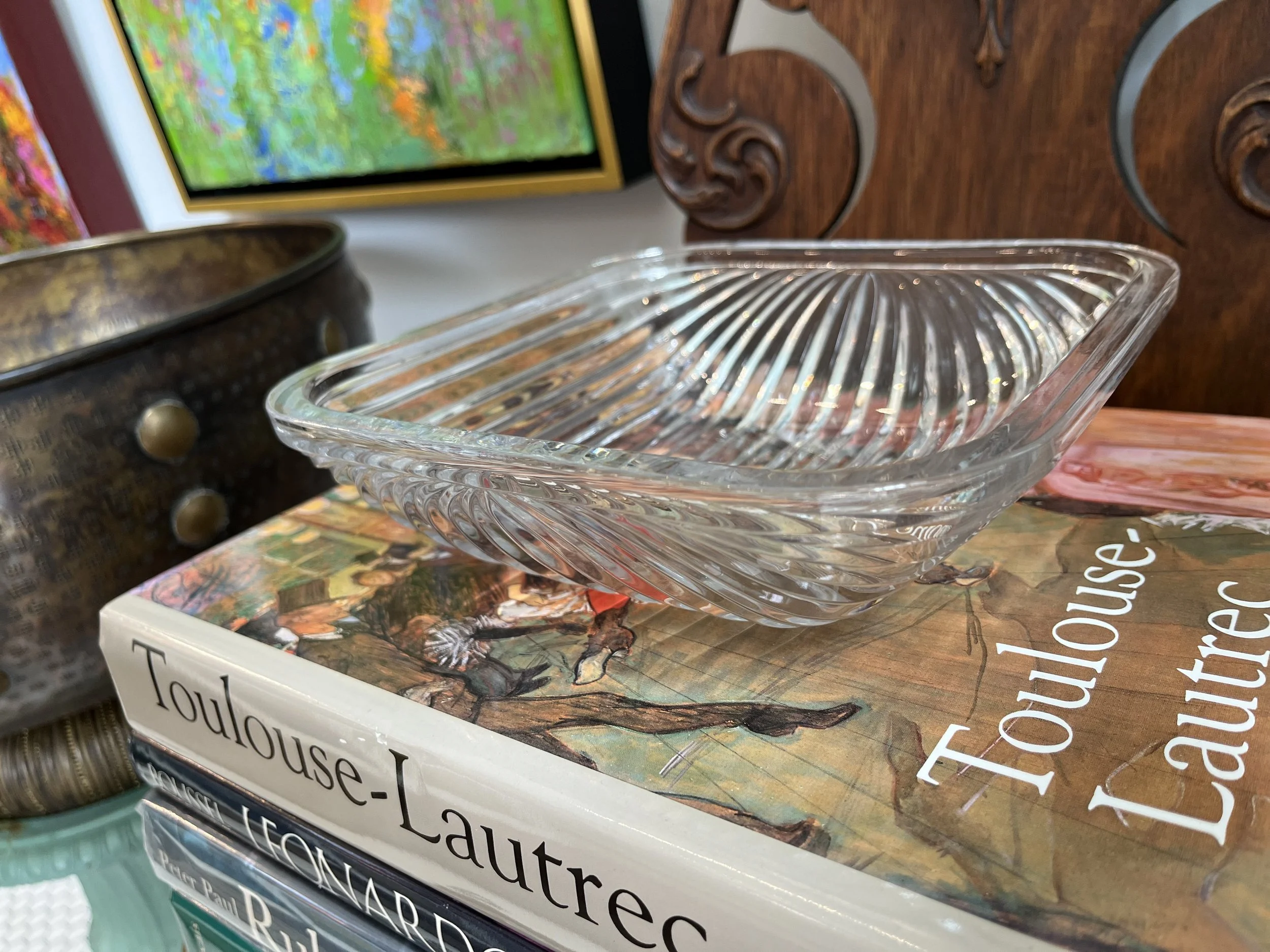


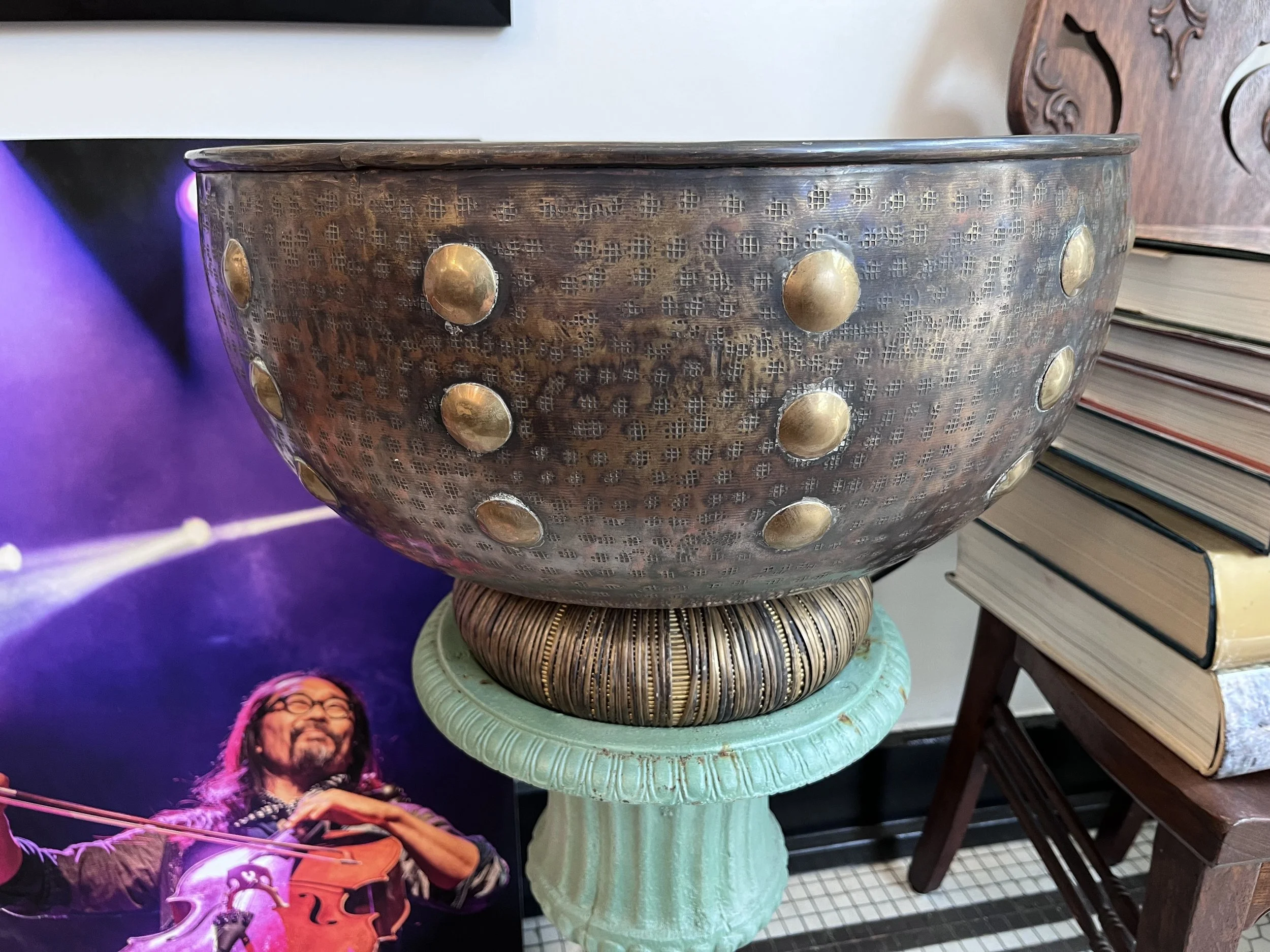
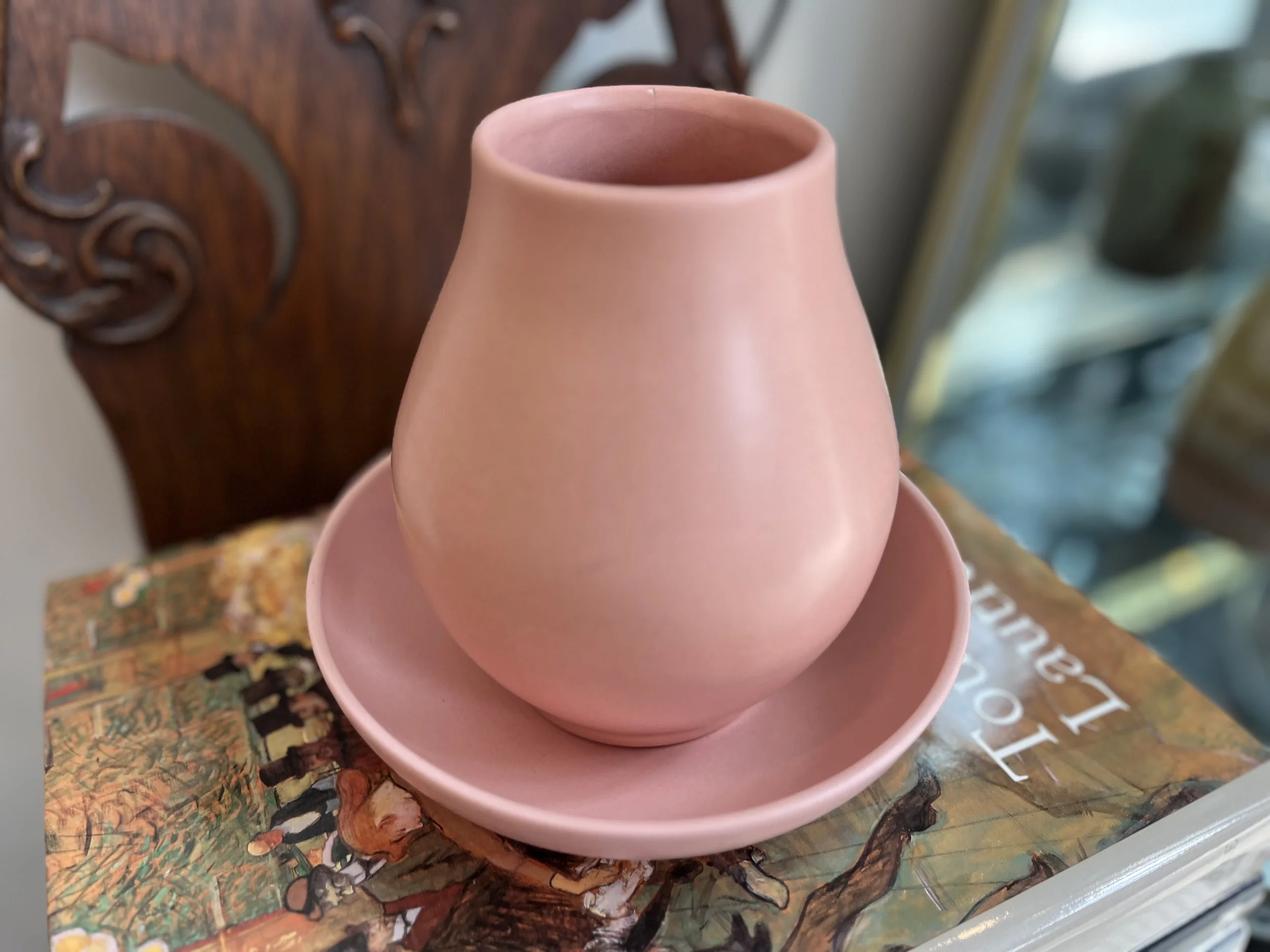
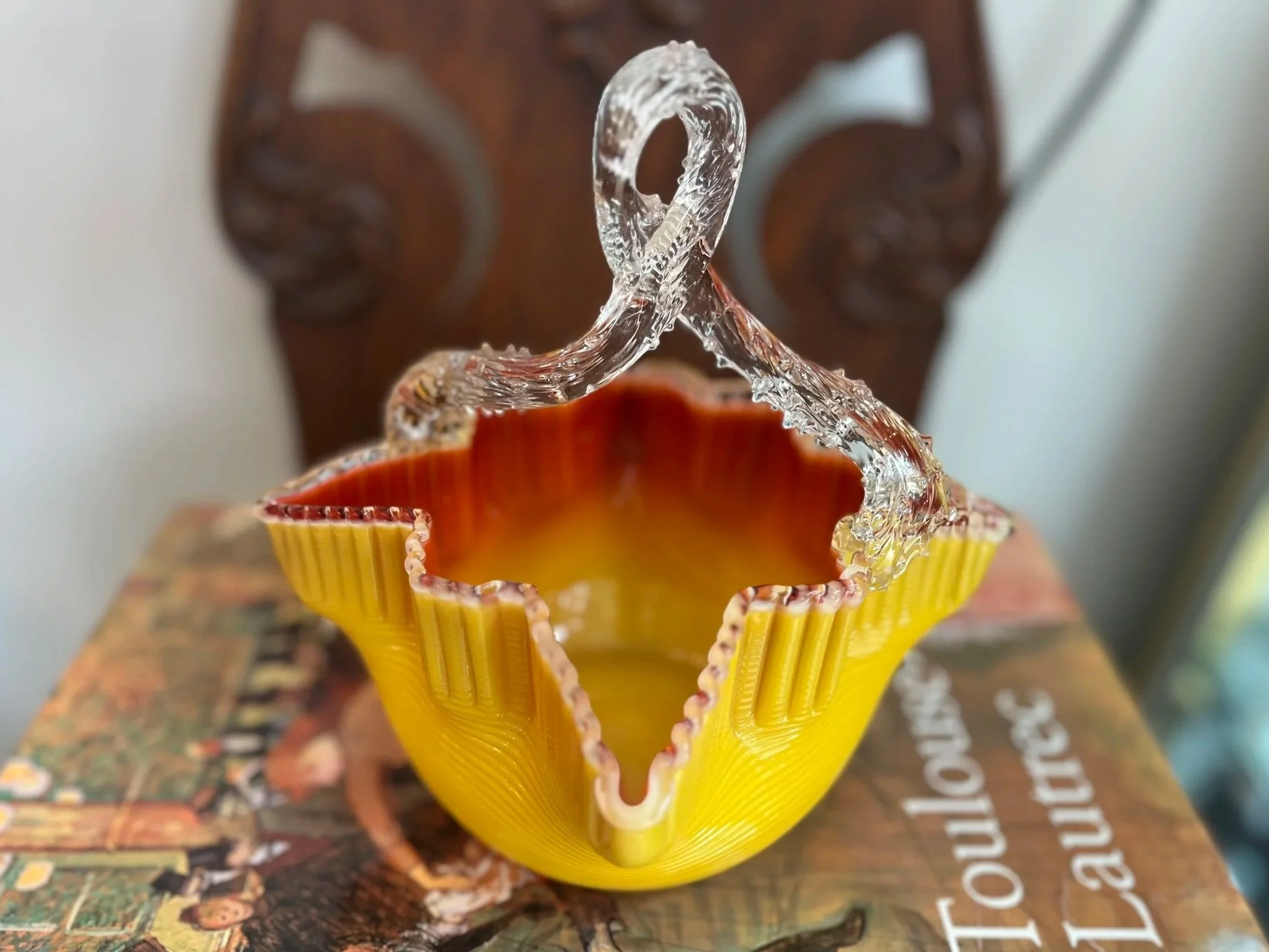

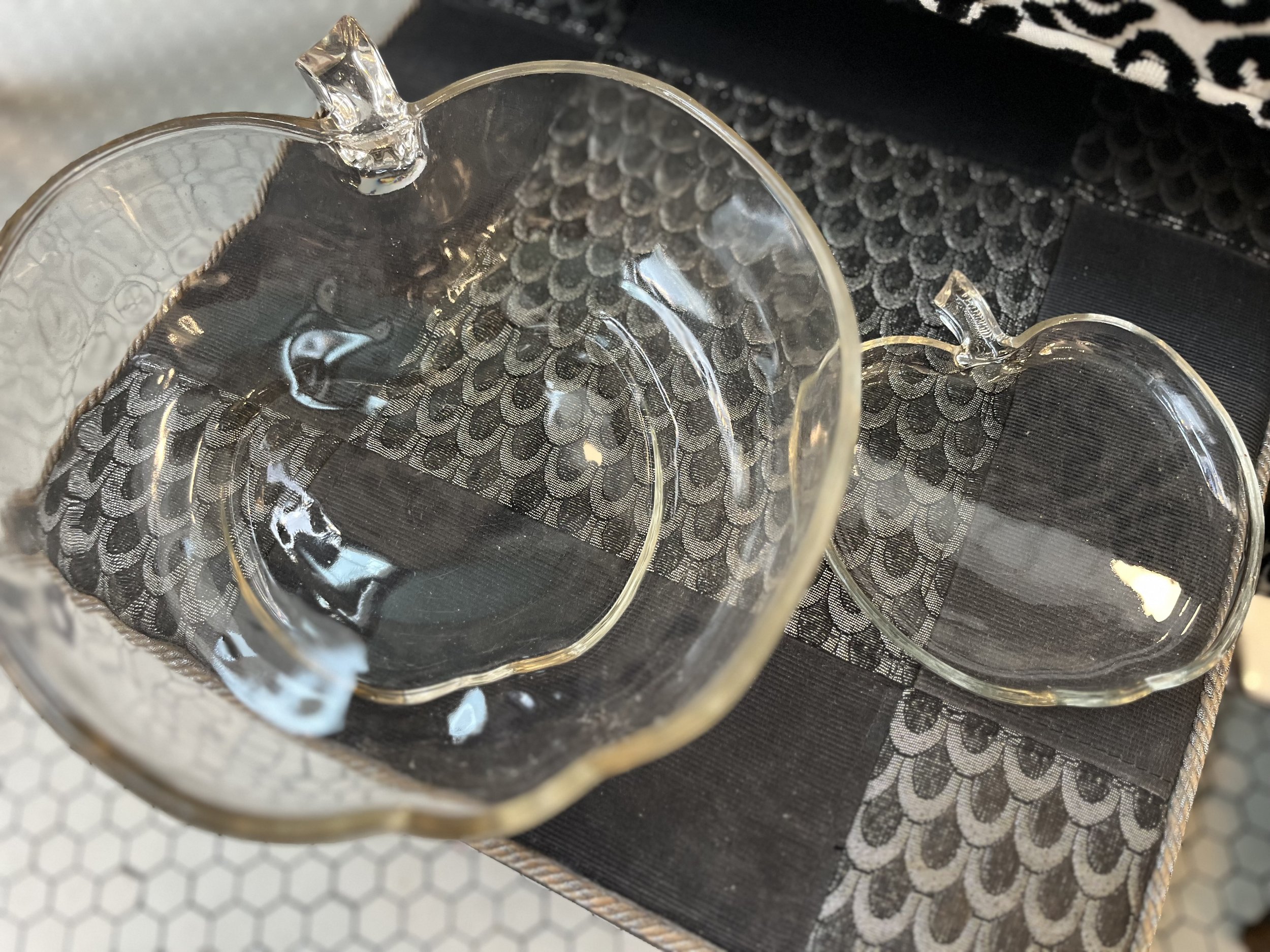
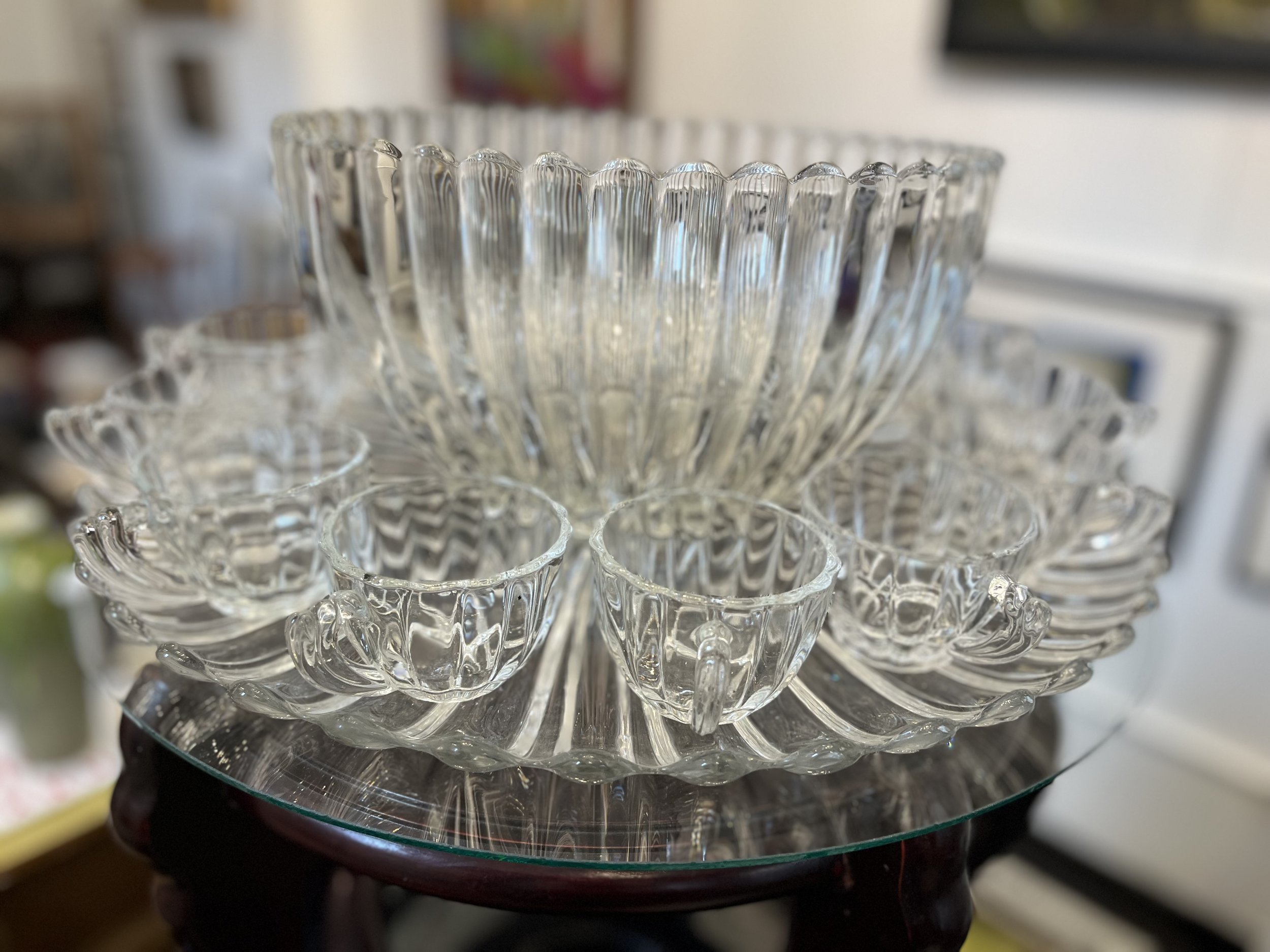







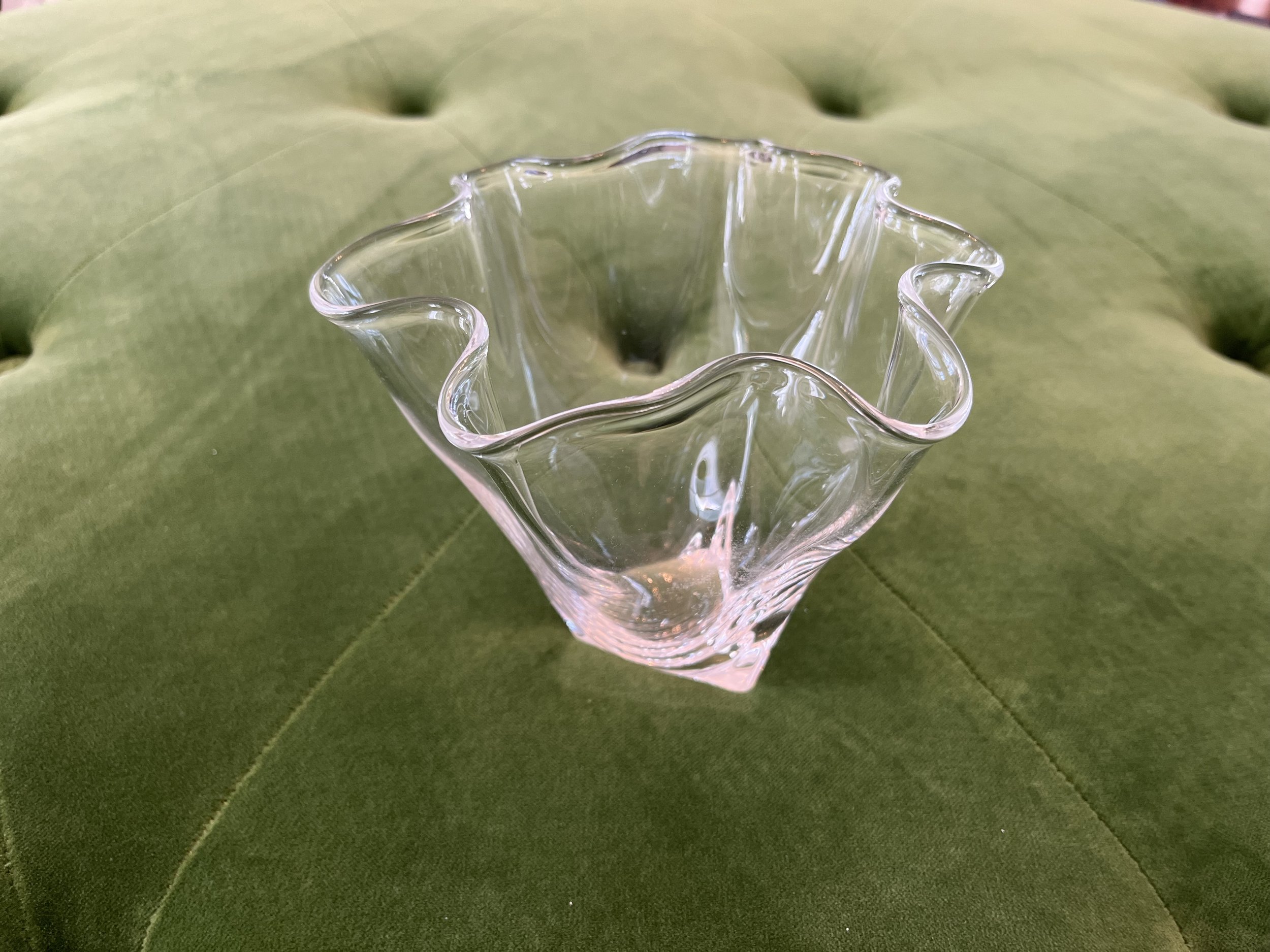



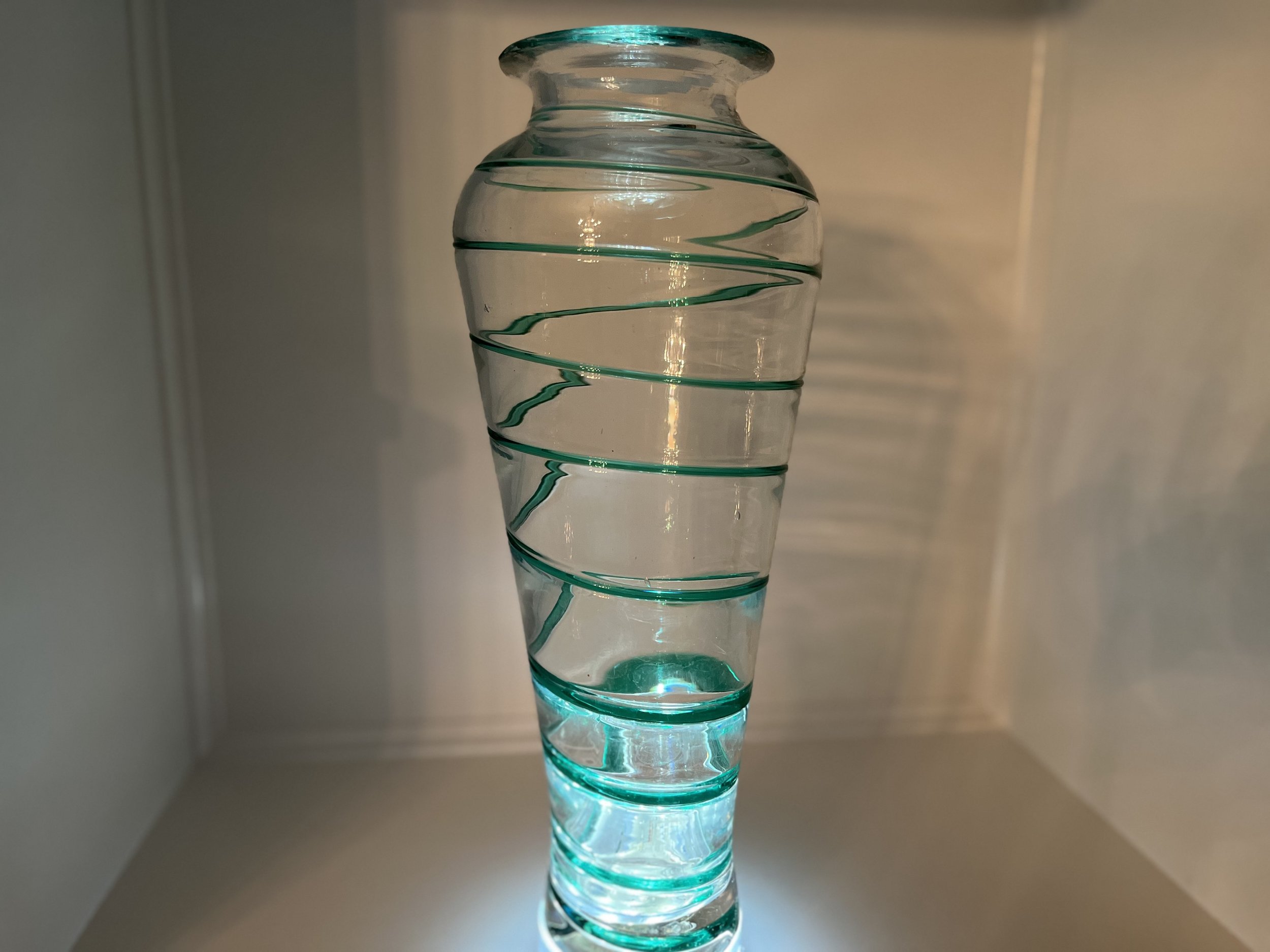
This particular vase, with its textured surface and variegated glaze, is characteristic of mid-20th century studio pottery. The impressed dot pattern and the way the glaze pools and drips suggest a deliberate artistic choice, aiming for a rustic yet refined appearance. Such pieces are often appreciated for their tactile qualities and the unique character imparted by the firing process, making them sought-after by collectors of contemporary craft and decorative arts.
Studio pottery emerged as a significant movement in the late 19th and early 20th centuries, emphasizing individual artistic expression and craftsmanship over mass production. Potters began to experiment with new forms, glazes, and firing techniques, moving away from purely functional ceramics towards decorative and sculptural pieces. This movement gained particular traction in Japan and the United States, with artists developing unique styles that reflected their cultural backgrounds and personal aesthetics.
To inquire about pricing and availability, please email BALL HILL The Arcade at info@ballhill.com.